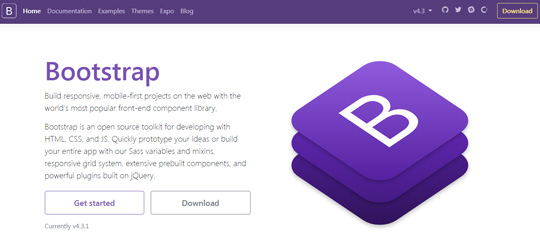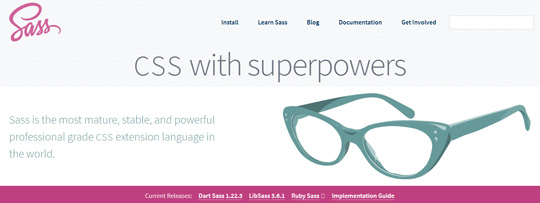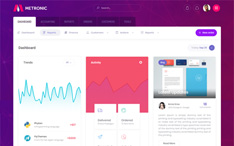
Web designing has come a long way throughout the years, as the number of people who took an interest in creating and purchasing websites grew in astonishing numbers.
Things went from simply focusing on practicality and functionality, to creating websites that are beyond impressive in their layout and dynamism.
But, what the regular web visitor or website buyer might not always realize is the amount of work and effort it takes to create these captivating websites that will make a project or business truly stand out.
However, as with most things, the first step behind any project is deciding what will it be created with, which brings us to today’s topic.
Deciding on the right framework to utilize for your next web design project is a very important part of the whole ordeal and it gets especially complicated when going through the several options available, and the suggestions about which one is better are overwhelming.
The discussion of Bootstrap vs. Foundation has been going on for years and a conclusion is yet to be drawn.
Our intention is to give you a general idea about what to expect from each of these two very popular frameworks and to help you decide which one would be the better choice for the project you intend to work on.
With that being said, let’s get started and hopefully you will have a better picture by the end of this article.
Contents:
- 1. What is Bootstrap?
- 2. What is Foundation?
- 3. What’s the Difference between Bootstrap and Foundation?
- 4. Which One is Better?
- 5. Which One Should You Learn?
- 6. Which One Should You Choose for Your Project?
- 7. Conclusion
1. What is Bootstrap?
Originally named Twitter Blueprint, Bootstrap is an open-source CSS framework, developed by Mark Otto and Jacob Thornton at Twitter.

Bootstrap is free, and being a front-end framework it is used to facilitate and consolidate the designing aspect of a project by reducing the time and amount of coding required. Not using a framework requires very good knowledge and considerable experience with coding, which in turn means a longer designing time and a lot of effort.
While that is a common feature that Bootstrap and other front-end frameworks share, Bootstrap has managed to set itself apart from most frameworks due to its lack of design rules and comes with an immense amount of information and resources from its online community.
Bootstrap relies primarily on CSS and HTML templates, including components of JavaScript as well, such as jQuery plugins.
Here we have many free Bootstrap templates, if you’re interested.
There is support to be found from developers that have first-hand experience with the framework and the coding documentation is well-done, making it easy to understand how the numerous components work and how to best use them.
All of these qualities are what make Bootstrap so widely used and beloved by web designers of all walks of life.
You might also like: 11 Best Bootstrap Admin and Dashboard Templates
2. What is Foundation?
Also a front-end CSS framework, Foundation was designed in 2011 by ZURB, with the purpose of facilitating the designing of beautiful and responsive websites and web apps.

It is a highly customizable framework that allows for fast and easy project development, with a developer-based approach, leaving plenty of room to work and play around with for designing projects that are easy to create and very visitor-friendly, both visually and functionally.
Foundation relies on both CSS and HTML UI components, as well as JavaScript extensions, which further extend its functionality.
The jQuery components of JavaScript were temporarily moved to Zepto, but then moved back again to jQuery due to it providing a faster experience for the user.
Foundation can be integrated in three levels, which include Ruby on Rails aside from CSS and SASS.
Like Bootstrap, it is an open source project and it creates responsive designs, with a focus on mobile-first web apps. It also features cross-browser compatibility, making your web projects accessible to everyone regardless of what device or browser they are on.
3. What’s the Difference between Bootstrap and Foundation?
Design Process and Customization
While both Bootstrap and Foundation come with a great number of components and elements that developers can utilize to create their projects, having so many options to choose from does not necessarily make things easier.
We did mention that CSS front-end frameworks are meant to cut down on time and effort put into web designing, but which of the two actually performs better?
Foundation, in general, makes for faster designing, but not necessarily easier.
While Bootstrap’s components are meant to mainly be used as they are, with some amount of customization available, Foundation is made for customization-heavy projects. Those that want to take their web project to the next level and tweak every little detail and component should really look into Foundation for that purpose.
When it comes to customization, both of them are loaded with components, templates and numerous interface elements, all of which make customization an interesting experience. Having so many features to tweak and work with leaves the developer with a lot of creative freedom, which is one of the best aspects of both Bootstrap and Foundation.
With that being said, Bootstrap is less complex in both its customization availability and its code, which makes it easier to use overall. These are especially important things to look for if you are a beginner, as Bootstrap’s online community will also prove to be of great help.
As for the resulting project that is created with either of these frameworks, Foundation’s customization ability greatly improves the visual aspect of a project. That is not to say Boostrap cannot do the same, but Foundation was built for creating unique and custom designs.
The inclusion of JavaScript components and plug-ins further adds to the number of elements that can be utilized to optimize the functionality of a project, and both of these frameworks rely on jQuery for some of its advanced features.
jQuery plug-ins are especially useful for animation and elements like slide-in menus, which help to make websites and web apps more dynamic and easier to attract visitors as well as easier to navigate.
Other comparison you might like: Material Design vs Bootstrap: Which One is Better?
Preprocessors and Compatibility
Both Bootstrap and Foundation rely on Sass preprocessors, but Bootstrap utilizes Less as well in its older versions (prior to version 4.0). They are both mobile-first CSS frameworks, but out of the two, Bootstrap is the one that results in better projects in this regard.

As for compatibility, both of these frameworks are compatible with modern browsers, including Safari for Mac and iOS, as well as Opera, Firefox, IE 9+ and Chrome for Windows, Android, Mac and iOS. They are fully responsive as well and accessible from all web-accessing devices.
Documentation and Support
It’s no secret that Bootstrap has one of the best code documentations out there and its large online community is a great help to those who need a bit of a boost and guidance when working on web projects.
The online community has also contributed to the vast number of custom templates and themes for Bootstrap, which help with easier project completion and it also helps you get a better feel and idea of how to utilize components.
Here we have some premium Bootstrap themes and templates.
Foundation’s community is far more limited and while its developers have provided guides and tutorials that help teach you about Foundation and how it should be used, it still is no match for Bootstrap’s available information and support online.
4. Which One is Better?
You have probably heard and read the answer “It depends” everywhere. And while it can be frustrating not coming to a clear cut and definitive answer, the truth of the matter is that there is no definitive answer in instances like this.
Both Bootstrap and Foundation are built with the same core function, that of making web designing easier and quicker, but their differences are what will ultimately determine which one is the better choice for your projects.
While Foundation is focused on the visual and customizability aspects of a project, Bootstrap is primarily focused on functionality and not so much in the way the final project will look. This last matter is why websites built with Bootstrap are regarded as being easily recognizable, or as having the “Bootstrap look”.
As we mentioned before, if you are looking to create a web project that is truly different from others in how it looks, we’d recommend you go for Foundation.
When it comes to creating both simple and complex functional projects, that will not take too much of your time in trying to understand and having to customize its framework, then Bootstrap is the better choice.
Online users tend to generally agree with us on this matter, too. In their experience, Foundation makes for a better choice when you are looking to create websites that stand out and its dynamic and appealing components are what give it the upper hand.
Bootstrap is a tried and tested framework that you cannot really go wrong with and the online support available, as mentioned previously, is of tremendous help, especially if you are just starting out.
5. Which One Should You Learn?
Technically, both of them are quite similar in how they work and function.
In our opinion, you should learn the one that better fits your project. While Bootstrap has a lot of tutorials, help and troubleshooting available all over the web, which makes it very suitable for those who wish to learn it, Foundation comes with its own guides and tutorials, too.
When looking into web designing and choosing the best designing framework, an important point should be to get used to the preprocessors they utilize. If you find Less easier and more comfortable, then Bootstrap is the one to learn.
On the other hand, if Sass proves to be the one that you prefer, then either Bootstrap or Foundation will do.
If you want to learn Bootstrap, here we have some Bootstrap tutorials.
6. Which One Should You Choose for Your Project?
As we mentioned above, you should go for the one that better suits the project you are working on.
If it’s functionality you are more concerned with and do not really mind the overall details in the appearance of your website, then Bootstrap is a better choice.
It’s easy to work with, easy to understand and does a great and foolproof job at creating websites that work well and are responsive.
However, if your main focus is to create a website that is beautiful in both the way that it navigates and functions, as well as in how it looks, then Foundation’s complex customizability are what you are looking for.
7. Conclusion
The available web designing frameworks are several and choosing the one that works best for you can be a hassle.
What we would advise is doing your research and trying out simple projects just to test the waters and see which of the frameworks you like best.
Focus on the preprocessors they use and then move on to features and overall functionality of the framework.
We discussed Bootstrap and Foundation as two of the most popular frameworks nowadays, which are often used as alternatives to each other.
Foundation’s grid system and its minimalist design and approach to the way its UI components are designed, give it the ability of extensive customization, which is what makes it one of the biggest Bootstrap rivals in the race for the best framework.
Bootstrap, on the other hand, comes with both fluid and fixed grid systems and its UI components are meant to be implemented and used “as-is”, helping the project develop much faster.
Your requirements will determine which of the two you should choose for your next project, but our choice for this comparison would be Foundation just because of the vast number of components it provides and its high customizability that results in very visually appealing projects.
Stay Updated
Subscribe to the Azmind Newsletter and I’ll update you as soon as I release a new WordPress Theme, Bootstrap Template, Tutorial or other Freebie:
To learn how we use your data when you sign up to our newsletter, read our Privacy Policy here.




